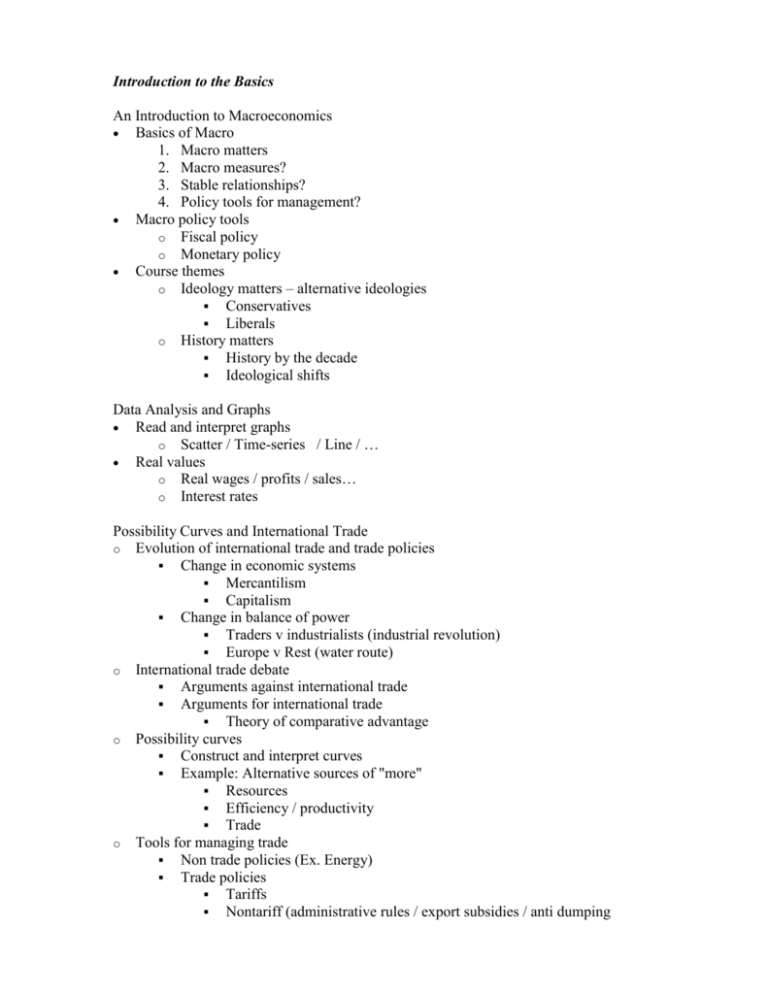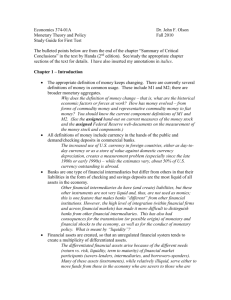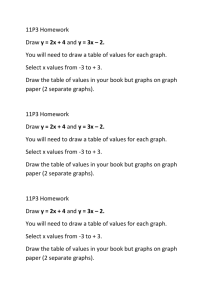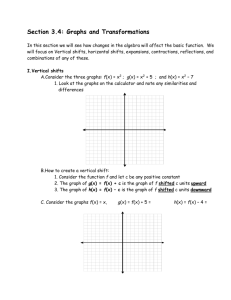Introduction to the Basics
advertisement

Introduction to the Basics An Introduction to Macroeconomics Basics of Macro 1. Macro matters 2. Macro measures? 3. Stable relationships? 4. Policy tools for management? Macro policy tools o Fiscal policy o Monetary policy Course themes o Ideology matters – alternative ideologies Conservatives Liberals o History matters History by the decade Ideological shifts Data Analysis and Graphs Read and interpret graphs o Scatter / Time-series / Line / … Real values o Real wages / profits / sales… o Interest rates Possibility Curves and International Trade o Evolution of international trade and trade policies Change in economic systems Mercantilism Capitalism Change in balance of power Traders v industrialists (industrial revolution) Europe v Rest (water route) o International trade debate Arguments against international trade Arguments for international trade Theory of comparative advantage o Possibility curves Construct and interpret curves Example: Alternative sources of "more" Resources Efficiency / productivity Trade o Tools for managing trade Non trade policies (Ex. Energy) Trade policies Tariffs Nontariff (administrative rules / export subsidies / anti dumping Quotas Exchange rates Track record of US trade policy Revolutionary times Civil War times Great Depression & WWII Post WWII GATT / WTO Track record of world trade policy o Asian export-led growth o o Supply & Demand Cookbook approach o Determinants of suppliers o Determinants of demanders Translate words about markets into S&D graphs o Change in quantity demanded / supplied (shift along curve) o Change in demand & supply (shift of entire curve) Translate S&D graphs into words o Comparative statics of S&D graphs – Single shifts Double shifts Forecasting / explaining prices and quantities The Basics of Macroeconomics Intro to Macroeconomics & Macro Models Circular flow model National Income Identity o Aggregate Supply = Aggregate Demand o Injections = Withdrawals o Investment = Savings AS-AD model (NOT SAME AS S&D model) o determinants of AS price and quantity of inputs productivity of inputs o determinants of AD / (C+I+G+X-M) C I G X M o Translate words into AS&AD graphs o Translate AS&AD graphs into words o Forecasting / explaining prices and quantities Single shifts Double shifts Macroeconomic Measurement o Measures of price, quantity, disequilibrium o Track record ( US and international) Labor Market Important relationships o Civilian population 16+ = Labor Force + Not in Labor Force o Labor Force = Employed + Unemployed o Labor Force Participation Rate = Labor Force/Civilian Population 16+ o Unemployment Rate = Unemployed/Labor Force o Employment population ratio = Employed / Population Track record of important variables Quantity - employment o Demographic factors Immigration boomers o Labor force participation rate Decomposition / trends o Employment Decomposition (industry, occupations, education) Disequlibrium - Unemployment rate o “missing” #s o Alternative measures of unemployment Price - earnings Real v nominal Output Market Track record o Domestic o International o Quantity - GDP o Definition o Decomposition of GDP o International comparisons PPP Exchange rate Limitations of GDP Nonmarket activities Leisure Bads Illegal activities Inequality New goods & quality changes Alternatives to GDP Reforming GDP Refining GDP o Price - CPI & inflation rate Costs of inflation Evolution of Macroeconomic Theory The 1930s: A Paradigm Shift Setting o Themes Industrialization Urbanization Globalization Regionalization Concentration o Drivers Demographics (immigration) Technology (communication, production, transportation, business) Public policies (immigration, anti trust, regulation, taxes, monetary (Fed) o Great Depression Ideological shift (crowding out to multiplier) Theoretical - Keynes (multiplier) Practical - Roosevelt (New Deal legislation) Classical Model (crowding out) o Equation of balance (X-M) + (I - S) + (G - T) = 0 Domestic balance (I – S) = 0? S&I graph International balance (X-M) = 0? Specie flow mechanism (Hume's law / Gold standard) Link between currency and gold Link between international trade balance and gold Link between gold and money supply Link between money supply and prices Quantity Theory V 1 MV = PY Quantity Theory V 2 m+v = y+p Link between prices and trade balance o Labor market: Assumption of full employment o Peculiarity of AS-AD model – vertical AS o Macro policy in Classical world Crowding out Monetary policy (m+v = y+p) Fiscal policy (G – T) = ? Keynesian Model (multiplier) o Great Depression o Alternative to Classical model Time frame / market efficiency Classical = long run / markets efficient Keynesian = short run / markets inefficient / sticky prices Focus of analysis Classical = AS Keynesian = AD o o o Impact of government policy Classical = Crowding out Keynesian = multiplier Multiplier Marginal propensity to consume Formula Peculiarity of AS-AD model – horizontal AS Macro policy in Keynesian depression world Monetary policy – not good in depression Fiscal policy – best in Depression The 1960s: Let the Good Times Roll Setting o Themes Industrialization Urbanization Globalization Regionalization Concentration o Drivers Demographics (immigration) Technology (communication, production, transportation, business) Public policies (immigration, anti trust, regulation, taxes, monetary (Fed) WW II Post WW II International Cold War Collapse of colonial empires National - ideological shift Extensions of Keynesian analysis o Detailed AD Consumption Why important? Components of spending Alternative models of spending Investment Why important? Supply-side effect Volatility Sensitivity to policies Components of spending o Forecasting time-series econometric barometric o Timing Temporary v permanent policies Lags (monetary v fiscal policy) Recognition, Discussion, Action o o Peculiarities of AS-AD graph Inflation & Phillips Curve Efficiency of labor market Shift of the Phillips Curve Types of unemployment Phillips curve and AS-AD model Shift along Phillips Curve Inflationary expectations and modified Phillips Curve The 1970s: Paradise Lost Setting o Themes Industrialization Urbanization Globalization Regionalization Concentration o Drivers Demographics (immigration) Technology (communication, production, transportation, business) Public policies (immigration, anti trust, regulation, taxes, monetary (Fed) o Great Depression Ideological shift Evolution of International Monetary Systems International accounting system BOPA o Debits (imports,....what we buy and who we buy it from o Credits (exports,...what we sell and who we sell it to o International balances Current Account Capital Account o Track record on trade patterns International monetary systems o Trilemma – goals of international monetary system Stable exchange rates Freedom of capital movement Independent monetary policy o Alternative systems Gold standard Flaw Example: UK Bretton Woods International agencies Flaw Nixon's dilemma Flexible exchange rates - Nixon's solution Translate words about markets into S&D graphs Supply of $s Demand for $s Translate S&D graphs into words Single shifts Double shifts Forecasting / explaining prices and quantities Bretton Woods II – or MAD II Evolution of Domestic Monetary System Evolution of money o commodity money o fiat money Measures of money o M1 o M2 Interest rates o Decomposition of interest rates r = rr +ri + rd + rl + rm o Real v Nominal (rr = r – i) o Yield curve / term structure of interest rates Money market o Money demand Classical transactions D (MV = PY) Keynesian Transactions Demand (income) Speculative Demand (interest rates) Money supply process o Fractional reserve system (Robin Hood) o Players Banks Fed (High powered money) Households & businesses o Regulation? Great Depression Glass-Steagell Act FDIC Separation of banks 1980-1990s Repeal of Glass-Steagell o Structure T-accounts o Fed's tools OMO Discount rate Required reserve rate Money market (Keynesian) o Translate words about markets into S&D graphs o o Supply of $s Demand for $s Translate S&D graphs into words Single shifts Double shifts Forecasting / explaining interest rates and money supply Money and economy o Liberal (Keynesian Theory) Transmission mechanisms interest sensitivity of money demand interest sensitivity of AD price response to AD Fed's 1970s dilemma Fed induced nflation spiral o Conservative (Quantity Theory) Monetarism definition Monetarism experiment o Evidence of Fed's policies o Differences between Keynesians and Monetarists The 1980s: A Paradigm Reversal Setting o Themes Industrialization Urbanization Globalization Regionalization Concentration Drivers o Demographics o Technology o Public policies Reaganomics o 1970s problem (Great Stagflation) Limitations of traditional AD policies o Reagan's solution Expand K (make I more attractive) Investment tax credit Accelerated depreciation Corporate profit tax 401 Ks Expand L Make work more attractive (tax cuts) Make not working less attractive (unemployment benefit & welfare cuts Tax cuts and balanced budgets Laffer Curve Limited impact of disinflation o Expectations Reagan's record Growth Equity Economic growth o International track record Very long run Growth rates Differentials in growth rates - divergence Change in balance of power o o Long run track record Transitional economies Africa Rise of Asia Slowdown in West Models of growth Classical Neoclassical (productivity) Decomposition of growth Intensive growth Extensive growth US track record Determinants of growth Location - yes Guns, germs, & steel Natural resources - maybe Structural change Cost-disease of the service sector Technological change Savings and investment Human capital Physical capital Public capital Institutions Business environment, Rule of law / culture / religion / The 1990s: The Visible Hand Setting o Demographics o Technology o Public policies Clinton, Greenspan & the New Economy o New Economy o AS – AD graphs Clinton the candidate Greenspan vision Clinton the president Federal government finances: o Budget deficit Track record Clinton turnaround Does the deficit matter? o National Debt Ownership of debt Burden of debt o Social Security Relationship to federal budget Forecasts of balance Policy tools to ‘correct’ future imbalances








